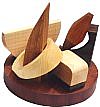
 |
home gallery |
| projects philosophy faq | |
 |
free plans: how to make a Block Stacking Game |
| Basic Description |
This is a fun and simple game that you can make from scraps of wood that you have leftover from other projects. As always, we offer a wide variety of options so you can customize the project and game rules to your suit your desires. It's a great game for two or more players and you can even play solitaire. It requires a unique combination of dexterity, strategy, and analysis that is enjoyed by players of all ages: its never the same game twice. |
Simply try to balance all the blocks on the base. If this is too easy, then you can either make the base smaller, make more blocks, make the shapes of the blocks more complicated, or put one or more of the blocks beneath the base rendering it slightly unstable. These variations provide an unlimited number of options. You can also time yourself and try to beat your record. How to Play a Multiplayer GameAny number of players can play: simply choose who is going first and alternate turns. It doesn't really matter who starts because the first several pieces cannot fall because they are placed directly on the base. A player places any block in any orientation on the base. Another player chooses a block and places it anywhere on the base or on a previously placed block. You cannot touch placed blocks with your hands and you cannot move blocks with the block that you are placing. If a block settles due to the weight of your block, that is fine, but you may not intentionally move existing blocks. The play alternates between players and gets progressively more difficult. You lose when the block you are placing falls or causes any other block(s) to fall off the base. |
 |
Alternative RulesThere are many alternative rules that provide a new flavor to the game. You can incorporate or replace any or all of the following rules in to the basic instructions: |
MaterialsYou can use any material but we chose wood because it is easy to work with, looks good and we had lots of scrap laying around. We made the game out of several different species of wood to add some complexity. SizeThe size of the blocks and the base are not critical for gameplay, but they do need to be properly sized to each other. If the pieces are very small, it will be difficult to place them but this would add a unique twist to gameplay: we envision a game played with tweezers. Remember that small pieces can be dangerous for young children. If you opt to make rather large blocks, you should refrain from placing blocks in a place where they can fall down on anyone or anything of importance. |
Number of BlocksWe made 27 blocks, but the number you need will be determined by several factors. You should make as many blocks as necessary to make it very difficult to place all the blocks in a game of solitaire. If it takes too many blocks to reach this critical point, then the gameplay will be very long and drawn out; the final stages of matches will be exciting, but the beginnings will tend to be less interesting. StorageThe blocks call out for a wooden box to store them in. Any box will do, but a particularly appealing solution is to make a customized shallow box for the pieces. You should complete this project first before beginning any box you choose to make so that you are sure of the dimensional requirements. |
 |
 |
© 2000-2008
terms privacy policy |
home gallery |
| projects philosophy faq | ||